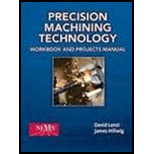
Precision Machining Technology (MindTap Course List)
2nd Edition
ISBN: 9781285444543
Author: Peter J. Hoffman, Eric S. Hopewell, Brian Janes
Publisher: Cengage Learning
expand_more
expand_more
format_list_bulleted
Concept explainers
Question
Chapter 5.1, Problem 4RQ
To determine
The two main components of carriage.
Expert Solution & Answer
Trending nowThis is a popular solution!

Students have asked these similar questions
500
Q3: The attachment shown in Fig.3 is made of
1040 HR. The static force is 30 kN. Specify the
weldment (give the pattern, electrode
number, type of weld, length of weld, and leg
size).
Fig. 3
All dimension
in mm
30 kN
100
(10 Marks)
(read image) (answer given)
A cylinder and a disk are used as pulleys, as shown in the figure. Using the data
given in the figure, if a body of mass m = 3 kg is released from rest after falling a
height h 1.5 m, find:
a) The velocity of the body.
b) The angular velocity of the disk.
c) The number of revolutions the cylinder has made.
T₁
F
Rd =
0.2 m
md =
2 kg
T
T₂1
Rc = 0.4 m
mc = 5 kg
☐ m = 3 kg
Chapter 5 Solutions
Precision Machining Technology (MindTap Course List)
Ch. 5.1 - List the four main parts of the engine lathe.Ch. 5.1 - What are the two main purposes of the lathe...Ch. 5.1 - What part of the lathe is used to set the feed...Ch. 5.1 - Prob. 4RQCh. 5.1 - Prob. 5RQCh. 5.1 - What is the purpose of the leads crew of a lathe?Ch. 5.1 - What two functions can the lathe tailstock...Ch. 5.1 - The standard taper in most lathe tailstocks is the...Ch. 5.1 - Define the swing and the bed length of a lathe.Ch. 5.2 - What is the special name for the type of jaw-type...
Ch. 5.2 - The most common variation of the above chuck has...Ch. 5.2 - Name two material shapes that can be properly held...Ch. 5.2 - List two advantages of using a self-centering...Ch. 5.2 - Name two material shapes that can be properly held...Ch. 5.2 - List three benefits of holding a workpiece between...Ch. 5.2 - List three potential advantages of using an...Ch. 5.2 - List three characteristics of a workpiece that...Ch. 5.2 - What type of mandrel would be ideal for gripping a...Ch. 5.2 - Name the type of tailstock center that raid be...Ch. 5.2 - What two auxiliary devices can be used to...Ch. 5.2 - Explain the differences between the two auxiliary...Ch. 5.2 - Name the device that is used to transmit the...Ch. 5.2 - Which two tool posts are the most efficient if...Ch. 5.2 - Which device may be used for either toolholding or...Ch. 5.3 - If a 0.050" depth of cut is taken on the diameter...Ch. 5.3 - A lathe cross slide uses a diameter-reading...Ch. 5.3 - In what units are feed rates measured for lathe...Ch. 5.3 - Are deeper cuts used for roughing or finishing...Ch. 5.3 - Calculate spindle RPM and machining time for...Ch. 5.3 - List three safety precautions related to clothing...Ch. 5.3 - What two materials are most commonly used for...Ch. 5.3 - What feature of a lathe cutting tool has a direct...Ch. 5.3 - Is a left-hand or right-hand tool normally used...Ch. 5.3 - What part of the lathe is used to feed the tool...Ch. 5.3 - When facing, why should the tool not be fed past...Ch. 5.3 - Should a left-hand or right-hand tool be used when...Ch. 5.3 - When and how should chips he removed from the work...Ch. 5.3 - What are two reasons for center drilling on the...Ch. 5.3 - When drilling and reaming on the lathe, how are...Ch. 5.3 - How can hole depth be controlled during drilling...Ch. 5.3 - What are two reasons boring may be selected to...Ch. 5.3 - Why must extra care be taken when performing...Ch. 5.3 - How can a tap be aligned when threading a hole on...Ch. 5.3 - Briefly define form cutting.Ch. 5.3 - How do grooving and cutoff speeds compare to...Ch. 5.3 - How can tool binding be overcome when cutting deep...Ch. 5.3 - List the two basic knurl patterns.Ch. 5.3 - How is knurling different from other lathe...Ch. 5.3 - List and briefly describe the two different types...Ch. 5.4 - The distance of actual contact of two mating...Ch. 5.4 - What feature of mating threads determines the...Ch. 5.4 - How many classes of fit are there in the Unified...Ch. 5.4 - Determine the major diameter limits for the...Ch. 5.4 - Determine the minor diameter limits for the...Ch. 5.4 - Determine the pitch diameter limits for the...Ch. 5.4 - Determine the approximate compound-rest in-feed...Ch. 5.4 - What is the name for the rotating device that...Ch. 5.4 - When threading, what is the reason for feeding the...Ch. 5.4 - Prob. 10RQCh. 5.4 - Why should the depth of cut be reduced for each...Ch. 5.4 - What dimension of the thread is measured by using...Ch. 5.4 - What measuring tool is used to visually inspect...Ch. 5.4 - List two applications of Acme threads.Ch. 5.4 - What type of thread is machined on a tapered...Ch. 5.5 - Briefly define a taper.Ch. 5.5 - What is the difference between an included angle...Ch. 5.5 - What does TPI stand for in relation to tapers?Ch. 5.5 - What are the TPI and TPF of a part with end...Ch. 5.5 - What are the corresponding centerline and included...Ch. 5.5 - What is the corresponding centerline angle of a...Ch. 5.5 - What is the limitation of the tool bit taper...Ch. 5.5 - What must be known to use the compound-rest taper...Ch. 5.5 - What taper turning methods allow use of the lathes...Ch. 5.5 - What two steps can be taken to eliminate backlash...Ch. 5.5 - The TPI specified on a print is 0.030". If...Ch. 5.5 - If TPF is 0.42", how much movement should register...Ch. 5.5 - What is the benefit of using the offset tailstock...Ch. 5.5 - What are two ways to reduce uneven pressure on...Ch. 5.5 - Calculate tailstock setover for a 13.5" part with...
Knowledge Booster
Learn more about
Need a deep-dive on the concept behind this application? Look no further. Learn more about this topic, mechanical-engineering and related others by exploring similar questions and additional content below.Similar questions
- (read image) (answer given)arrow_forward11-5. Compute all the dimensional changes for the steel bar when subjected to the loads shown. The proportional limit of the steel is 230 MPa. 265 kN 100 mm 600 kN 25 mm thickness X Z 600 kN 450 mm E=207×103 MPa; μ= 0.25 265 kNarrow_forwardT₁ F Rd = 0.2 m md = 2 kg T₂ Tz1 Rc = 0.4 m mc = 5 kg m = 3 kgarrow_forward
- 2. Find a basis of solutions by the Frobenius method. Try to identify the series as expansions of known functions. (x + 2)²y" + (x + 2)y' - y = 0 ; Hint: Let: z = x+2arrow_forward1. Find a power series solution in powers of x. y" - y' + x²y = 0arrow_forward3. Find a basis of solutions by the Frobenius method. Try to identify the series as expansions of known functions. 8x2y" +10xy' + (x 1)y = 0 -arrow_forward
- Hello I was going over the solution for this probem and I'm a bit confused on the last part. Can you please explain to me 1^4 was used for the Co of the tubular cross section? Thank you!arrow_forwardBlood (HD = 0.45 in large diameter tubes) is forced through hollow fiber tubes that are 20 µm in diameter.Equating the volumetric flowrate expressions from (1) assuming marginal zone theory and (2) using an apparentviscosity for the blood, estimate the marginal zone thickness at this diameter. The viscosity of plasma is 1.2 cParrow_forwardQ2: Find the shear load on bolt A for the connection shown in Figure 2. Dimensions are in mm Fig. 2 24 0-0 0-0 A 180kN (10 Markarrow_forward
- determine the direction and magnitude of angular velocity ω3 of link CD in the four-bar linkage using the relative velocity graphical methodarrow_forwardFour-bar linkage mechanism, AB=40mm, BC=60mm, CD=70mm, AD=80mm, =60°, w1=10rad/s. Determine the direction and magnitude of w3 using relative motion graphical method. A B 2 3 77777 477777arrow_forwardFour-bar linkage mechanism, AB=40mm, BC=60mm, CD=70mm, AD=80mm, =60°, w1=10rad/s. Determine the direction and magnitude of w3 using relative motion graphical method. A B 2 3 77777 477777arrow_forward
arrow_back_ios
SEE MORE QUESTIONS
arrow_forward_ios
Recommended textbooks for you
 Precision Machining Technology (MindTap Course Li...Mechanical EngineeringISBN:9781285444543Author:Peter J. Hoffman, Eric S. Hopewell, Brian JanesPublisher:Cengage Learning
Precision Machining Technology (MindTap Course Li...Mechanical EngineeringISBN:9781285444543Author:Peter J. Hoffman, Eric S. Hopewell, Brian JanesPublisher:Cengage Learning Automotive Technology: A Systems Approach (MindTa...Mechanical EngineeringISBN:9781133612315Author:Jack Erjavec, Rob ThompsonPublisher:Cengage Learning
Automotive Technology: A Systems Approach (MindTa...Mechanical EngineeringISBN:9781133612315Author:Jack Erjavec, Rob ThompsonPublisher:Cengage Learning Automotive TechnologyMechanical EngineeringISBN:9781337794213Author:ERJAVEC, Jack.Publisher:Cengage,
Automotive TechnologyMechanical EngineeringISBN:9781337794213Author:ERJAVEC, Jack.Publisher:Cengage, Welding: Principles and Applications (MindTap Cou...Mechanical EngineeringISBN:9781305494695Author:Larry JeffusPublisher:Cengage Learning
Welding: Principles and Applications (MindTap Cou...Mechanical EngineeringISBN:9781305494695Author:Larry JeffusPublisher:Cengage Learning

Precision Machining Technology (MindTap Course Li...
Mechanical Engineering
ISBN:9781285444543
Author:Peter J. Hoffman, Eric S. Hopewell, Brian Janes
Publisher:Cengage Learning

Automotive Technology: A Systems Approach (MindTa...
Mechanical Engineering
ISBN:9781133612315
Author:Jack Erjavec, Rob Thompson
Publisher:Cengage Learning

Automotive Technology
Mechanical Engineering
ISBN:9781337794213
Author:ERJAVEC, Jack.
Publisher:Cengage,

Welding: Principles and Applications (MindTap Cou...
Mechanical Engineering
ISBN:9781305494695
Author:Larry Jeffus
Publisher:Cengage Learning